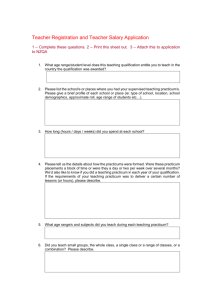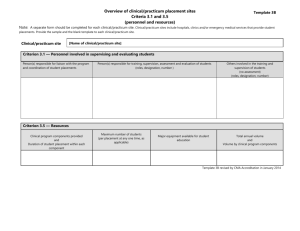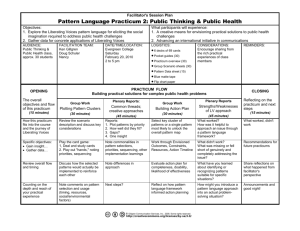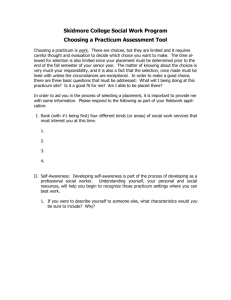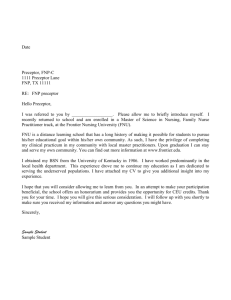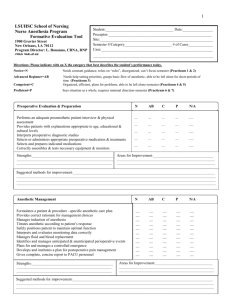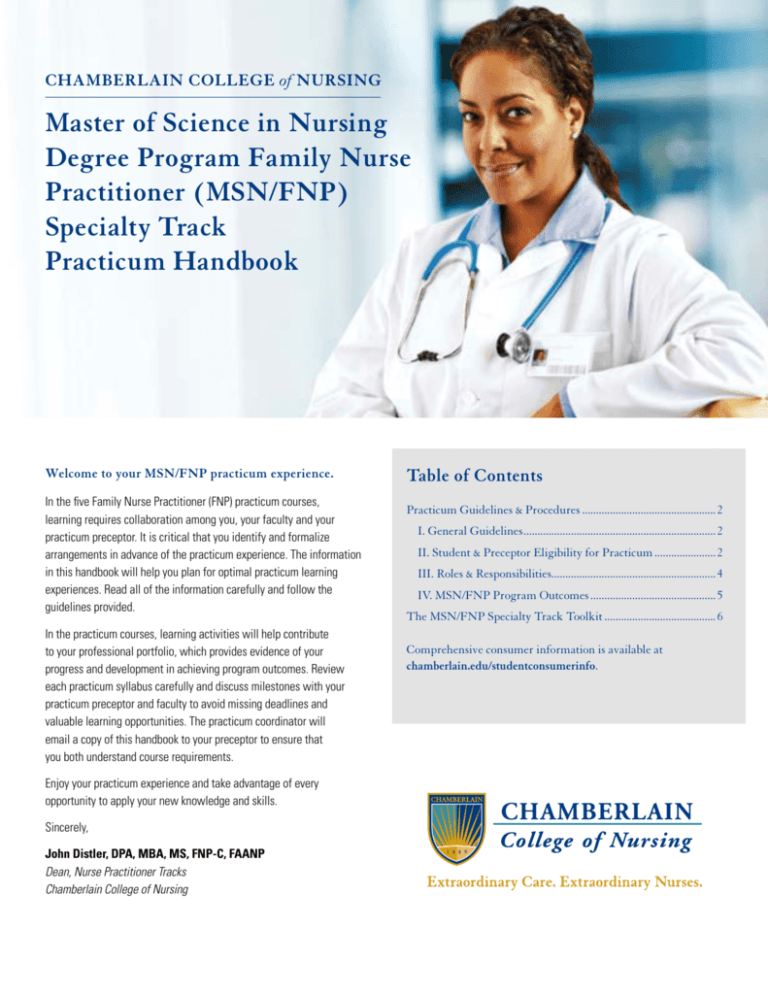
CHAMBERLAIN COLLEGE of NURSING
Master of Science in Nursing
Degree Program Family Nurse
Practitioner (MSN/FNP)
Specialty Track
Practicum Handbook
Welcome to your MSN/FNP practicum experience.
In the five Family Nurse Practitioner (FNP) practicum courses,
learning requires collaboration among you, your faculty and your
practicum preceptor. It is critical that you identify and formalize
arrangements in advance of the practicum experience. The information
in this handbook will help you plan for optimal practicum learning
experiences. Read all of the information carefully and follow the
guidelines provided.
In the practicum courses, learning activities will help contribute
to your professional portfolio, which provides evidence of your
progress and development in achieving program outcomes. Review
each practicum syllabus carefully and discuss milestones with your
practicum preceptor and faculty to avoid missing deadlines and
valuable learning opportunities. The practicum coordinator will
email a copy of this handbook to your preceptor to ensure that
you both understand course requirements.
Enjoy your practicum experience and take advantage of every
opportunity to apply your new knowledge and skills.
Sincerely,
John Distler, DPA, MBA, MS, FNP-C, FAANP
Dean, Nurse Practitioner Tracks
Chamberlain College of Nursing
Table of Contents
Practicum Guidelines & Procedures................................................. 2
I. General Guidelines...................................................................... 2
II. Student & Preceptor Eligibility for Practicum....................... 2
III. Roles & Responsibilities............................................................ 4
IV. MSN/FNP Program Outcomes.............................................. 5
The MSN/FNP Specialty Track Toolkit......................................... 6
Comprehensive consumer information is available at
chamberlain.edu/studentconsumerinfo.
CHAMBERLAIN COLLEGE OF NURSING MSN/FNP PRACTICUM HANDBOOK
Practicum Guidelines & Procedures
I. General Guidelines
The practicum courses offer nurse practitioner students an
opportunity to apply newly developed skills and relate theoretical
content to advanced practice nursing situations. This professional
experiential learning helps further prepare students for the highest
level of advanced practice. On a larger scale, it allows students
to enhance skills in communication, teamwork, critical thinking
and professionalism.
You are responsible for identifying an appropriate location and
preceptor for your practicum – a minimum of 120 days prior to the
beginning of the first practicum course. It is highly recommended
that you select a practicum site that will be available for support
and learning in all five practicum courses.
During the practicum, you will inform your preceptor(s) about
course requirements and personal learning goals. You are also
responsible for maintaining a log of the practicum experiences,
including accurate reflections on activities and attainment of
course outcomes and specialty competencies. Each assigned
faculty member is responsible for evaluating your performance
and all associated assignments completed during the practicum
experience. You are responsible for making travel arrangements
and paying for all related practicum expenses.
You must be scheduled and are responsible for completing a total
of 625 hours of practical experience in approved and supervised
settings (125 hours in each practicum course). The scheduled hours
will be arranged in conjunction with your approved practicum site
and preceptor (as is reasonable to satisfy the practice experience
requirement). Chamberlain allows flexibility in scheduling these
hours. The requirement may be met with full days, partial days or
consecutive days as agreed upon with your preceptor. If you cannot
complete the required 125 practicum hours within the time frame of
the practicum course, and have completed a minimum of 75 percent
of the course requirements, you will receive a grade of Incomplete.
Incompletes must be resolved within six weeks of the end of the
course or sooner, as determined by the practicum course faculty.
As a professional responsibility, you are required to schedule
practicum hours so that patient safety is assured.
II. Student & Preceptor Eligibility for Practicum
1. Prerequisite Requirements for Students
• C omplete NR-500, NR-501, NR-503, NR-505, NR-506, NR-512
(MSN core courses) and NR-507, NR-508, NR-510 and NR-509.
A suggested curriculum plan is available on chamberlain.edu
or by clicking here
• Submit all necessary documents as requested by your
practicum and compliance coordination teams.
2. Preceptor Qualifications
The FNP preceptor must possess a master’s degree in nursing at
the minimum, be nationally board-certified as a nurse practitioner
and hold an active advanced practice license. The preceptor must
also have at least one year of practice as a nurse practitioner. Other
types of health professionals may also serve as a preceptor for FNP
students: (e.g. Medical Doctor (MD) or Doctor of Osteopathy (DO)).
MDs and DOs must have an active medical license.
All preceptors must have applicable expertise and the ability to
help you achieve your learning goals. Preceptors must be willing
and available to work with you in a setting where advanced practice
nursing is allowed to contribute to the improvement of clinical care.
Although having the same preceptor for all practicum courses is
not required, it is highly encouraged as this promotes continuity
of learning and the development of a professional and collegial
relationships. The use of multiple preceptors must be approved
by the practicum course faculty and communicated to the student’s
practicum coordinator. The Preceptor Profile and resume or
Curriculum Vitae (CV) must be provided for each preceptor
along with any applicable license or board certifications.
If you are unable to submit your preceptor’s resume/CV and license
(such as an APRN license) along with your practicum site application
or you can email them to FNPpracticum@chamberlain.edu.
Be sure to include your name and D# in the email.
When you fill out the practicum application you will be required
to provide the following about your preceptor:
1. Name
2. Contact information (email, address, phone, etc.)
3. Title and credentials
4. Degrees, licensure and certifications
5. Y ears of experience (must be a practicing FNP for at least
one year)
6. Resume or CV
2
CHAMBERLAIN COLLEGE OF NURSING MSN/FNP PRACTICUM HANDBOOK
3. Practicum Site Selection
C. Practicum Application
Securing a practicum site and preceptor can take several
months so it’s best to begin the process early in your program.
The application for your proposed practicum site, preceptor
Curriculum Vitae (CV) and preceptor license must be submitted to
Chamberlain a minimum of 120 days prior to the start of NR-511,
your first practicum course. If you identified a potential site and/or
preceptor during the admission process, you still must fill out and
submit the practicum application form 120 days before the start
of your first practicum.
Once the site has been selected and preceptor(s) identified:
Once you submit your practicum site application, your practicum
team will work with your site to secure a clinical affiliation
agreement and any other legal documents that may be required.
If you are currently employed at your selected site, these legal
documents may still be necessary.
• C omplete the Practicum Application at least 120 days prior to
the beginning of the first practicum course and anytime there
are any new practicum sites throughout the program
• S ubmit the qualifying information for each preceptor that
will support the practicum experience
- Current resume or CV
- Evidence of licensure
- Evidence of advanced practice certification (if applicable)
The Practicum Application for your preferred site(s) must be submitted
at least 120 days before the start of the first practicum course. Once
you have selected your practicum preceptor and site, follow the
steps below to submit your Practicum Application online:
Once all the required contracts are signed and your preceptor
is approved, you may have to fulfill additional site requirements
such as pass a drug screen/background check, provide additional
immunization history, etc. You will be provided a comprehensive
list of your responsibilities and these must be fulfilled at least
30 days prior to the start of your practicum.
1. Go to my.chamberlain.edu
A. Location for Practicum Experience
5. U
nder the Category drop down menu choose Registrar and
then Online Practicum Application
• When identifying an appropriate practicum site, start with
your personal and professional network and then branch out
as needed. Be sure you read all the information in this handbook.
• There is information designed to help you find a practicum site and
preceptor on your student portal. Go to my.chamberlain.edu >
My Degree & Courses > Post Licensure Practicum >
MSN FNP Practicum and Immersions.
• It is important to remember that the practicum gives personnel in
facilities the opportunity to observe you as a potential employee;
you may consider employment goals in selecting a site as well.
B. Criteria for Site Selection
• The site must be a healthcare or nursing institution consistent
with the learning needs of your advanced practice specialty
(e.g. an outpatient family practice or primary care clinic)
• The site may be in the institution where you are currently
employed but you must function outside of your RN role
and work as an FNP student with your preceptor
• NR-511 and NR-601 must take place at a family practice site
or retail clinic. Remaining practicum courses may take place
at specialty sites such as a women’s health clinic
• You must have an active, unrestricted nursing license in the
state where you will be completing your practicum
Direct all questions about site selection to practicum operations
at FNPpracticum@chamberlain.edu.
2. Login with your Student ID (D#)
3. Click on Ask a Question
4. U
nder the School drop down menu choose
Chamberlain College of Nursing and then Online – FNP
6. Click Continue
7. Fill in all of the information in the blank fields
8. A
ttach your preceptor’s resume or CV, license and advanced
practice certification (if applicable)
9. Click Submit
D. Site Agreements
A Clinical Affiliation Agreement is required for all practicum sites.
Your practicum coordination team will work with your site to secure
the necessary contracts. The clinical affiliation agreement must
be signed by a duly authorized officer from the facility being used
for the practicum experience and returned to Chamberlain. In the
event Chamberlain is unable to reach the contact indicated on your
practicum application, your practicum coordination team may seek
your assistance in communicating with the site. Chamberlain will
still secure the contracts on your behalf, but it is your responsibility
to help ensure meaningful communication is established between
Chamberlain and your chosen site.
The process of completing site contracts can take several weeks
to months. The practicum application must be submitted at least
120 days prior to the start of the first practicum course and 120 days
prior to the start of any subsequent practicum course in which the
practicum site is changed. The practicum coordinator is available
to assist with contractual agreements.
3
CHAMBERLAIN COLLEGE OF NURSING MSN/FNP PRACTICUM HANDBOOK
4. Clinical Compliance Requirements
1. Responsibilities of Faculty
There are a number a documents that must be submitted at least
30 days prior to your practicum start date. Some are required by
Chamberlain, others may be required by your practicum site. Your
clinical compliance team will send you a comprehensive list of all
required documentation.
• Is available via email or telephone to provide support to
you and your preceptor during each practicum course.
It is your responsibility to ensure all requirements are understood
and completed 30 days prior to beginning the practicum experience at
each site. This may include, but is not limited to: liability insurance,
background check, drug screening, immunizations, proof of health
insurance, evidence of HIPAA training, current CPR certification or
other requirements.
A listing of possible requirements can be found by reviewing
the Post-licensure Clinical Compliance Packet.
5. Portfolio
Throughout the FNP program, you will collect selected assignments
and compile them as artifacts within a Professional Portfolio
to demonstrate professional growth and expertise. The final
portfolio, which will be submitted at the end of the degree program,
will be assessed against the learning outcomes of the program.
Chamberlain College of Nursing will provide detailed information
regarding how and when to submit the Professional Portfolio at
the end of the program.
6. Practicum Log
• S erves as a combination of facilitator, organizer, professional
relations coordinator, role model, coach and mentor.
•M
aintains ongoing and effective communication throughout
each practicum experience.
• C onducts regular meetings with you and your preceptor
will be conducted via teleconference.
• R esponsible for the final evaluation of your learning.
2. Responsibilities of Chamberlain College of Nursing
•D
efine competencies as a foundation for student learning
goals in each practicum course
• R eview and approve practicum site and preceptor for
appropriateness for meeting student learning goals
and course outcomes
• S uggest activities to enhance the educational experience
• P rovide a faculty member to serve as instructor and facilitator
• Instruct students to abide by practicum site policies, procedures
and requirements
• Investigate and respond to complaints from the practicum site,
preceptor or student
The FNP Practicum Log is maintained through eLogs and must be
submitted to the faculty and included in your portfolio. Documentation
must demonstrate activities related to course outcomes and specialty
competencies. All hours must be documented on the FNP Practicum Log
and signed by the preceptor. Travel time to and from the practicum site
and time spent working on the practicum portfolio documentation shall
not be included in the practicum hours. Both you and your preceptor
will receive instructions on how to access and use eLogs.
• Maintain communication with student and preceptor during
the practicum course
7. Ethical Behavior
• C ontact the practicum site and identify required
compliance documentation
You are expected to present professional demeanor, behavior,
appearance and communication at all times. You must comply with
the policies in the Chamberlain College of Nursing Student Handbook
which can be found at chamberlain.edu/handbook. As indicated
in the handbook, you are bound by the American Nurses Association
Code of Ethics. You must also agree to abide by all requirements,
policies and procedures of the practicum site.
III. Roles & Responsibilities
A successful practicum experience requires collaboration among
course faculty, students, preceptors, practicum coordinators and
the College. Students, faculty and preceptors must assure that
practicum hours are not misappropriated or falsely represented
during the practicum experience. Practicum hours are intended
to facilitate learning and must be focused on helping the
student achieve learning goals.
• R efrain from unlawful discrimination on the basis of gender,
age, race, color, national origin, religion, sexual orientation,
political affiliation or belief or disability
• Evaluate academic performance of students in the course
3. Responsibilities of the Practicum Coordinator
• Confirm student compliance with site requirements prior
to the start of each practicum course
• C ontact the preceptor and provide the course syllabus,
preceptor manual and practicum handbook
• F acilitate the process of changing preceptor(s) when requested
by a student and approved by the faculty member
•A
t the completion of the course, send a survey to preceptors,
students and faculty regarding the overall practicum experience
4. Responsibilities of the Practicum Preceptor
• C ollaborate with Chamberlain faculty to promote student success
in the practicum courses
•O
rient the student to the practicum site environment, policies
and procedures
• Identify suitable experiential opportunities that align with
the course outcomes
• S erve as mentor for students in professional development
4
CHAMBERLAIN COLLEGE OF NURSING MSN/FNP PRACTICUM HANDBOOK
• Ensure students do not replace paid staff
Orientation to the Practicum
• Provide supervision of the student’s clinical practice
and constructive feedback about his or her performance
in the practicum
Information about the practicum experience is available via the
Chamberlain Student Portal at my.chamberlain.edu. The portal
includes tips for finding a practicum site and preceptor, description
of the practicum, forms, grading rubrics and contact information.
• Protect from disclosure all personal student-identifying
information or records of student’s participation except
as set forth by an agreement or required by law
• Refrain from unlawful discrimination on the basis of gender,
age, race, color, national origin, religion, sexual orientation,
political affiliation or belief or disability
• Provide feedback to Chamberlain and attend meetings with
faculty as requested
Preceptor Receipt of Handbook
You should verify that their preceptor(s) receives an electronic copy
of this handbook and the FNP Preceptor Resource Manual from
the practicum coordinator(s) to ensure understanding of course
requirements and the preceptor role.
Direct all questions about the practicum to your practicum
coordinator at FNPpracticum@chamberlain.edu.
5. Responsibilities of the Student
• Submit a Practicum Application at least 120 days prior to
the start of the first practicum course and 120 days prior
to a change in the practicum site
IV. MSN/FNP Program Outcomes
• Obtain and submit required documents for preceptor(s)
At the completion of the Chamberlain College of Nursing MSN/FNP
Program, the graduate will be able to:
• Assist as needed with completion of required clinical
affiliation agreement with the practicum site
1. P ractice safe, high-quality advanced nursing care based on
concepts and knowledge from nursing and related disciplines
• Be familiar with all policies and procedures related
to practicum experiences
2. C onstruct processes for leading and promoting quality
improvement and safety in advanced nursing practice
and healthcare delivery
• Meet deadline dates for all assignments and
learning activities
• Demonstrate competence in practicum assignments
• Abide by practicum site rules and regulations
• Conduct oneself in a professional manner during the
practicum assignment
• Accept instruction from facility personnel as a
learning opportunity
• Maintain communication with the course faculty
• Maintain practicum log as instructed by faculty
• Comply with all practicum site and clinical compliance
requirements throughout all practicum experiences, which
may include, but are not limited to: proof of liability insurance,
HIPAA training, proof of licensure, proof of CPR certification
or other requirements, background screening, physical
examination, drug screening, proof of health insurance
and current immunizations
3. U
se contemporary communication modalities effectively
in advanced nursing roles
4. E valuate the design, implementation and outcomes of strategies
developed to meet healthcare needs
5. D
evelop a plan for lifelong personal and professional growth
that integrates professional values regarding scholarship,
service and global engagement
6. A
pply legal, ethical and human-caring principles to situations
in advanced nursing practice
7. D
esign patient-centered care models and delivery systems using
the best available scientific evidence
8. M
anage human, fiscal and physical resources to achieve
and support individual and organizational goals
9. C ompose a plan for systematic inquiry and dissemination
of findings to support advanced nursing practice, patient-care
innovation and the nursing profession
• Conduct formative evaluation of the practicum experience
and actively seek early resolution if learning goals are not
being met
10. C ollaborate interprofessionally in research, education,
practice, health policy and leadership to improve population
health outcomes
• Integrate learning goals that lead to the development of
competencies noted in the MSN Essentials for Advanced
Practice Nursing as published by the American Association
of Colleges of Nursing and the Nurse Practitioner Core
Competencies published by the National Organization
of Nurse Practitioner Faculties
11. A
pply principles of informatics to manage data and information
in order to support effective decision making
Admission and graduation requirements for the MSN program
can be found in the current academic catalog at
chamberlain.edu/catalog
• Perform a self-evaluation on the practicum experience
• Provide for and fund all travel arrangements and any
associated expenses
5
Our Mission:
To educate, empower
and embolden diverse
healthcare professionals
who advance the health
of people, families,
communities and nations.
THE MSN/FNP SPECIALTY TRACK TOOLKIT
Literature
Forms & Worksheets
Catalog
FNP Clinical Compliance Packet
Viewbook
FNP Practicum Application Guide
MSN Curriculum Grid
FNP Practicum Application (Reference Only)
Academic Calendar
FNP Preceptor Profile (Reference Only)
For more information, email FNPpracticum@chamberlain.edu
Chamberlain College of Nursing is certified to operate by the State Council of Higher Education for Virginia, 101 N. 14th Street,
10th floor, James Monroe Building, Richmond VA 23219, 804.225.2600. Chamberlain College of Nursing is approved to operate by
the Virginia Board of Nursing Perimeter Center, 9960 Mayland Drive, Suite 300, Henrico, VA 23233-1463, 804.367.4515. Unresolved
complaints may be reported to the Illinois Board of Higher Education through the online complaint system http://complaints.ibhe.org/
or by mail to 1 N. Old State Capitol Plaza, Suite 333, Springfield, IL 62701-1377. Chamberlain College of Nursing is authorized for
operation by the THEC, http://www.tn.gov/thec.
For the most updated approvals by state information, visit chamberlain.edu/stateapprovals. Program/program option availability
varies by state/location. Chamberlain reserves the right to update information as it becomes available. Information is current
at the time of publication. Comprehensive consumer information is available at chamberlain.edu/studentconsumerinfo.
12-130664.8
©2016 Chamberlain College of Nursing LLC. All Rights Reserved. 0216pflcp_v2e

